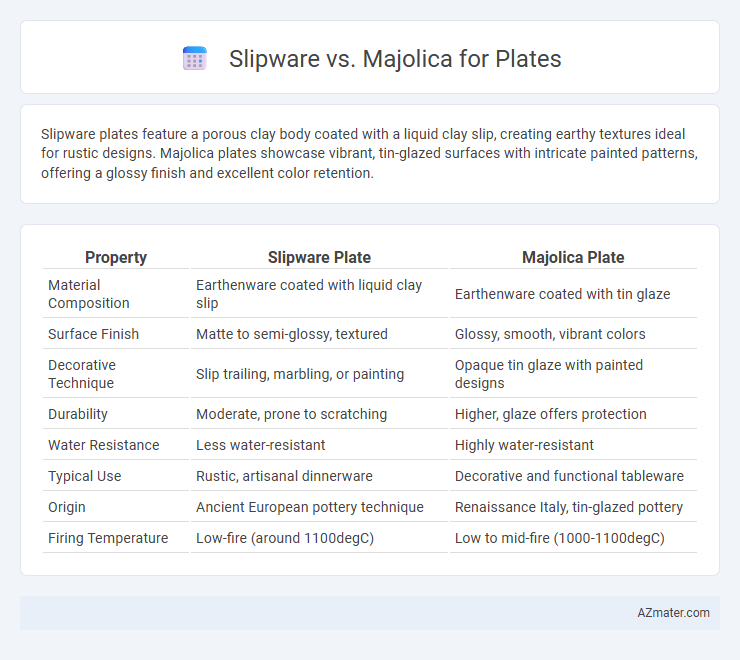Slipware plates feature a porous clay body coated with a liquid clay slip, creating earthy textures ideal for rustic designs. Majolica plates showcase vibrant, tin-glazed surfaces with intricate painted patterns, offering a glossy finish and excellent color retention.
Table of Comparison
| Property | Slipware Plate | Majolica Plate |
|---|---|---|
| Material Composition | Earthenware coated with liquid clay slip | Earthenware coated with tin glaze |
| Surface Finish | Matte to semi-glossy, textured | Glossy, smooth, vibrant colors |
| Decorative Technique | Slip trailing, marbling, or painting | Opaque tin glaze with painted designs |
| Durability | Moderate, prone to scratching | Higher, glaze offers protection |
| Water Resistance | Less water-resistant | Highly water-resistant |
| Typical Use | Rustic, artisanal dinnerware | Decorative and functional tableware |
| Origin | Ancient European pottery technique | Renaissance Italy, tin-glazed pottery |
| Firing Temperature | Low-fire (around 1100degC) | Low to mid-fire (1000-1100degC) |
Understanding Slipware: Definition and Origin
Slipware refers to pottery decorated with slip, a liquid mixture of clay and water applied to the surface before firing, originating in ancient civilizations such as Mesopotamia and Egypt. This technique allows for intricate designs and textures by layering or carving the slip before the final glaze is applied. Slipware plates showcase a tactile, earthy aesthetic, contrasting with the brightly colored, tin-glazed surface of Majolica pottery.
What is Majolica? Historical Background
Majolica is a type of earthenware pottery characterized by its vibrant, tin-glazed surface that creates a glossy, opaque white base for painted decoration. Originating in the Renaissance period, particularly in 15th-century Italy, majolica became popular for its intricate designs and bright colors inspired by Moorish and Islamic influences. Historically, majolica served both utilitarian and decorative purposes, often representing floral, mythological, and heraldic motifs on plates and other ceramics.
Materials and Techniques: Slipware vs Majolica
Slipware plates feature a base of earthenware clay coated with liquid clay slip, which is often colored or textured, and then decorated by applying slips in various patterns before firing. Majolica plates use a tin-glazed earthenware technique where a white, opaque glaze is applied to the surface, providing a bright, glossy background for hand-painted designs often created with metal oxide pigments. The key difference lies in slipware's reliance on slip decoration for texture and patterns, while majolica emphasizes vibrant, painted imagery on a smooth, reflective glaze.
Visual Differences: Colors, Patterns, and Textures
Slipware plates exhibit earthy, muted tones with layered, swirling patterns created by applying liquid clay slips over the surface, resulting in a textured, tactile feel. Majolica plates are distinguished by their vibrant, glossy glazes painted in bold colors, often featuring intricate floral or figurative motifs with a smooth, glass-like finish. The visual contrast lies in slipware's organic, rustic appearance versus majolica's bright, polished, and highly decorative style.
Durability and Practical Use in Plates
Slipware plates, coated with a layer of liquid clay slip, offer moderate durability but can be prone to chipping due to their often thinner glaze. Majolica plates feature a tin-glazed earthenware finish that provides a harder, more resilient surface resistant to stains and wear, making them more suitable for daily use. In terms of practicality, Majolica's non-porous glaze enhances hygiene and ease of cleaning, whereas Slipware may require more careful handling to maintain its decorative slip layer.
Artistic Styles in Slipware and Majolica Plates
Slipware plates showcase intricate designs created by applying liquid clay slips in contrasting colors, emphasizing bold patterns and textured surfaces that highlight rustic, folk-art aesthetics. Majolica plates feature vibrant, tin-glazed surfaces with detailed, colorful paintings often depicting floral motifs, mythological scenes, and baroque influences, resulting in a glossy finish that enhances fine artistic detail. Both styles reflect distinct historical ceramic traditions, with slipware rooted in utilitarian craft and majolica celebrated for its decorative, mural-like artistry.
Popular Regions and Cultural Associations
Slipware plates are traditionally associated with English and American folk pottery, featuring slip-trailing and sgraffito techniques that highlight rustic, earthy designs popular in rural communities. Majolica plates, originating from Renaissance Italy, are renowned for their vibrant tin-glazed surfaces and intricate painted motifs, commonly found in Mediterranean regions like Spain and Portugal. Both styles carry strong cultural identities, with Slipware reflecting utilitarian craftsmanship and Majolica representing decorative art linked to aristocratic and historical Mediterranean traditions.
Maintenance and Care for Slipware and Majolica Plates
Slipware plates require gentle hand washing with mild soap and avoidance of abrasive scrubbers to preserve their textured slip decoration and prevent chipping. Majolica plates, known for their vibrant tin-glazed surface, should be cleaned carefully with a soft cloth and mild detergent to maintain the glaze's sheen and avoid crazing or cracking. Both types benefit from avoidance of dishwashers and extreme temperature changes to prolong their durability and aesthetic appeal.
Collectibility and Market Value Comparison
Slipware plates, known for their distinctive slip-decoration technique and rustic appeal, generally attract collectors interested in folk art and historical pottery, often commanding moderate market values due to their widespread production. Majolica plates display vibrant, tin-glazed surfaces with intricate designs, appealing to collectors favoring colorful and decorative ceramics, which typically achieve higher market prices in specialized antique markets. The collectibility of Majolica is boosted by its association with 19th-century European craftsmanship, whereas Slipware's value depends more on regional origin and rarity, influencing overall market demand and price fluctuations.
Choosing the Right Plate: Slipware or Majolica?
Slipware plates feature intricate designs created by applying liquid clay slip over a contrasting clay body, resulting in a matte, textured surface ideal for rustic or artisanal table settings. Majolica plates are renowned for their vibrant tin-glazed surface with colorful, glossy decoration that resists stains and enhances food presentation. Selecting between slipware and majolica depends on your preference for durability, aesthetic style, and maintenance, with slipware offering earthy charm and majolica providing vivid, easy-to-clean elegance.

Infographic: Slipware vs Majolica for Plate
 azmater.com
azmater.com